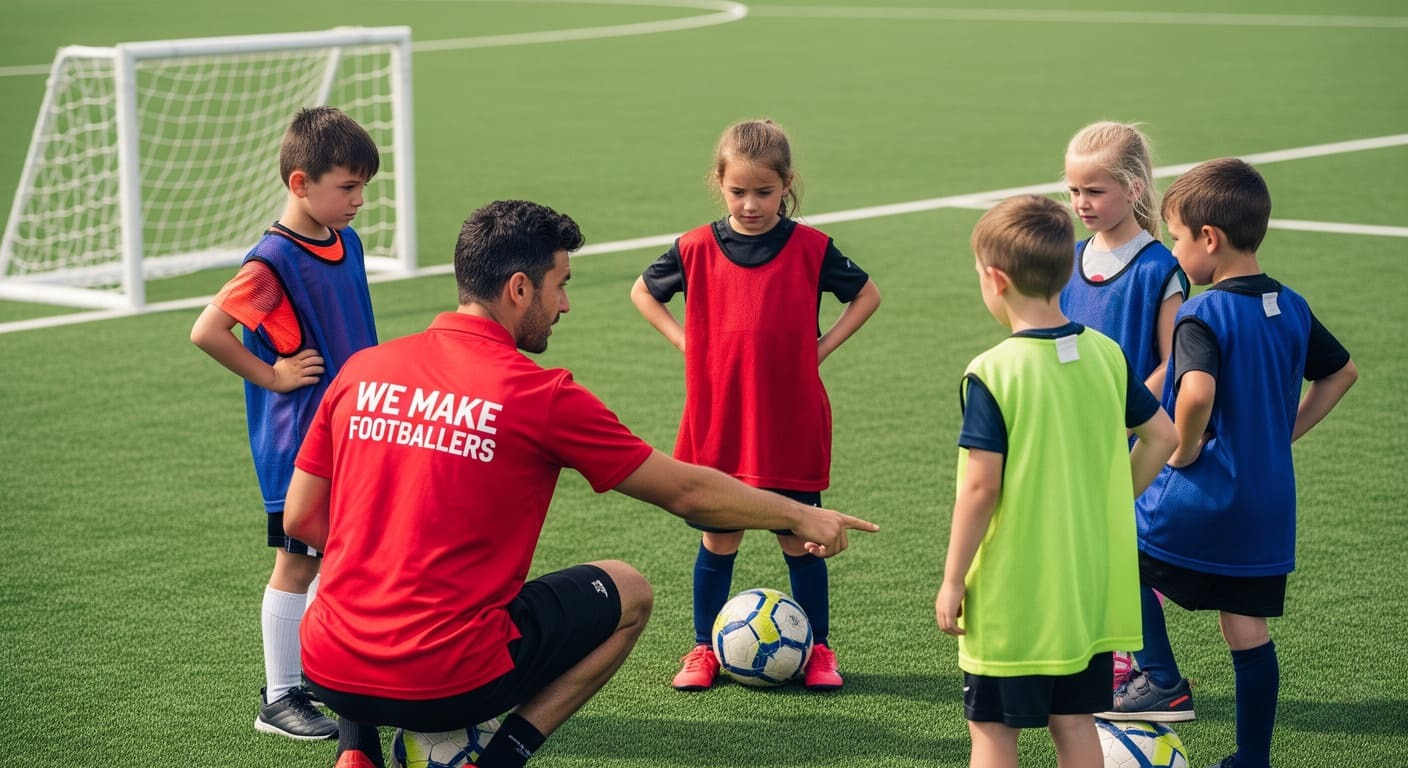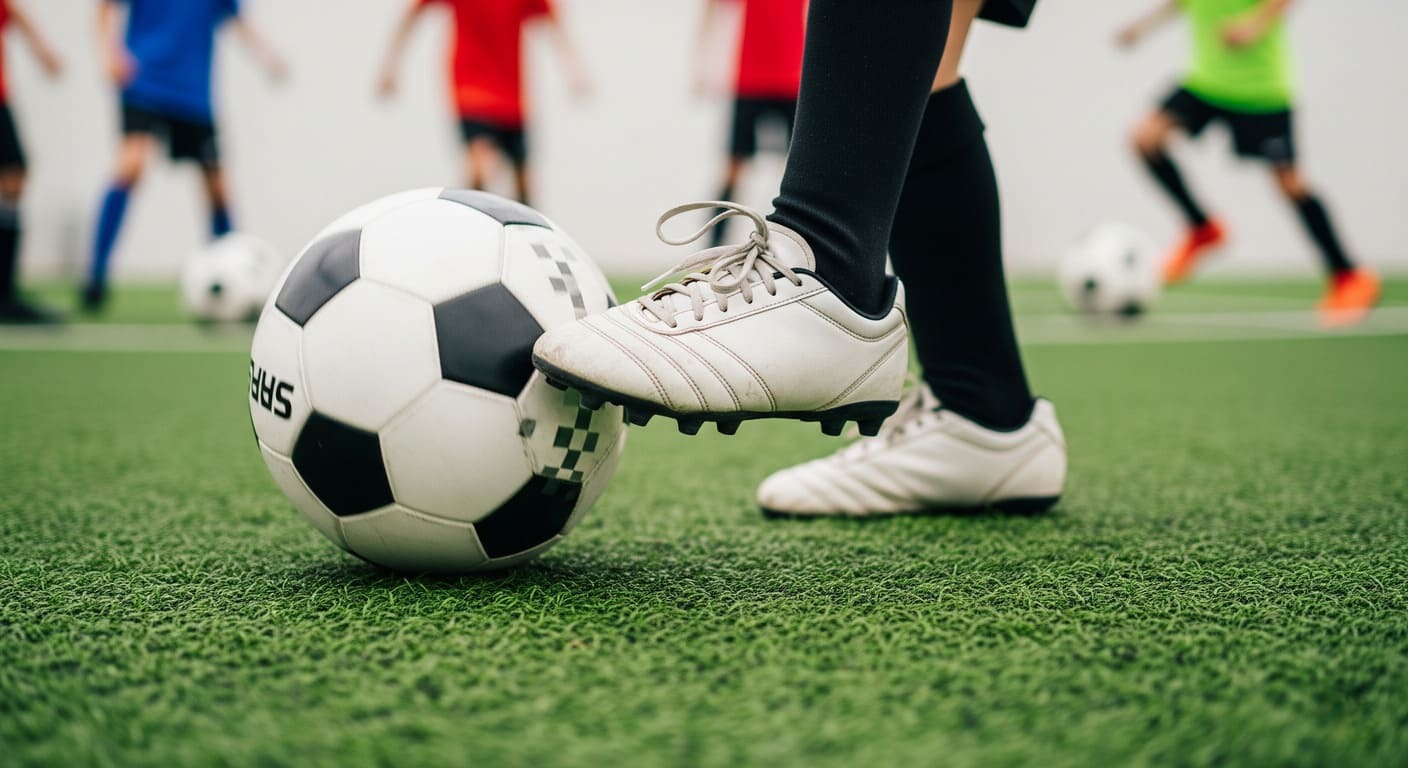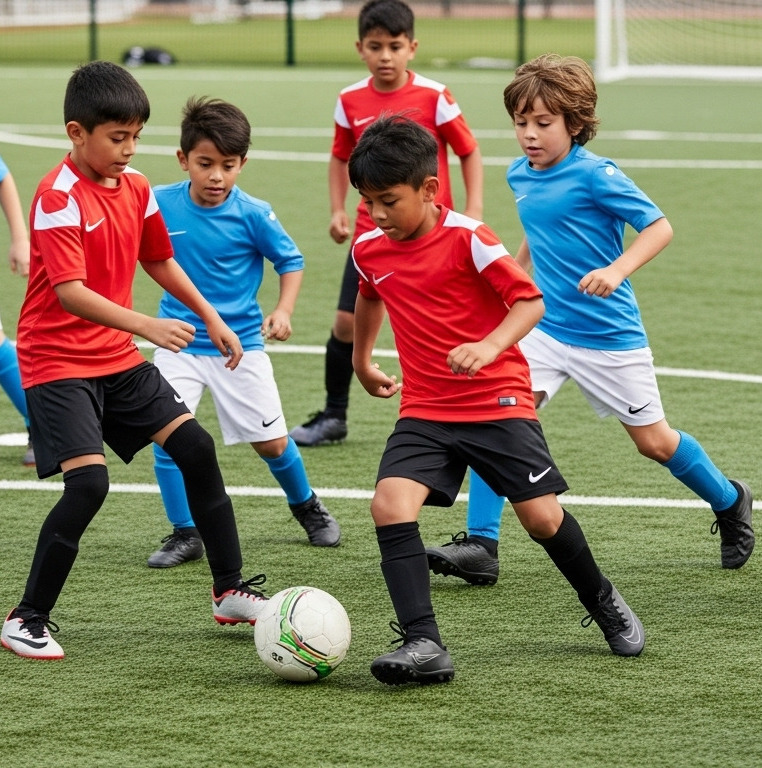Unlocking Potential: How Rondo Drills Transform Young Footballers
At first glance, a rondo looks like a simple game: players form a circle or square, pass a ball around, and one or two players chase it down in the middle. But in today’s game, especially at the grassroots and academy levels that circle is where some of the most powerful coaching happens.
It’s more than a warm-up. It’s more than a drill. It’s a complete footballing education in a small space. A football rondo blends technical execution, timing, teamwork, problem-solving, and communication all in one drill. And at We Make Footballers, it’s central to how we help young players grow.
Whether your child is just learning how to pass or thinking two moves ahead, the rondo game gives them opportunities to sharpen their skills, test their awareness, and build creative confidence like nothing else.
Introduction to Rondo
A rondo football drill is a training exercise in which a group of players aim to keep possession against a smaller number of defenders in a tight area. Offenders try to string together passes without losing control. Defenders aim to intercept or force mistakes. When the defender wins the ball, they switch out with the attacker who gave it away.
On the surface, this seems like a fun passing game. But dig a little deeper and you'll see the essential components of match play: controlling tight spaces, thinking before receiving, hitting accurate passes, scanning defenders, communicating under pressure.
This is what makes a rondo drill so versatile. It offers high repetition of match-relevant scenarios but in a condensed, engaging format. At We Make Footballers, we incorporate rondos into almost all of our sessions from early learning with 4-year-olds to more elite-level practice with academy trials.
Because they’re fun, players love them. And while they’re having fun, they’re also developing real match intelligence.
Benefits of Using Rondos in Football Training
When done right, rondo training drills offer one of the most effective ways to accelerate learning in young footballers. This is why clubs, academies, and coaching organisations across the world rely on them, including us at We Make Footballers.
So what exactly are the benefits?
Technical Development
Because rondos happen in tight areas, players must improve their first touch very quickly. Every second matters. Poor control or slow reactions mean a quick turnover. Over time, round after round, players enhance their sharpness and build muscle memory for tighter games.
Alongside that, they get hundreds of natural pass repetitions. Not aimless passing—but under pressure, within motion. These are the kinds of passes they’ll need to make in 5-a-side, 7-a-side, and eventually in 11-a-side matches. The speed and sharp angles in a rondo passing drill shortcut what would usually take months of experience.
Mental Agility and Decision-Making
Rondo training trains brains to anticipate rather than react. Children start to learn how to think a step before the ball reaches them. They understand when to hold, when to switch, when to make space for a teammate—concepts that separate good players from great ones.
Beneath the surface, players are developing concentration, discipline, timing, and resilience. All through play.
Teamwork and Communication
A rondo game only works if players work as a unit. They must move together, support each other, and communicate constantly. Kids who struggle speaking up during matches come out of their shells in rondos.
Because the format is contained, it's easier for shyer kids to feel heard. They get multiple chances to contribute and improve in just a few minutes. At We Make Footballers, we see this boost in confidence every week with newer players who blossom round after round.
Fun and Motivation
Let’s not forget: kids stay in football because they enjoy it. Rondos are fast, energising, and naturally competitive. They allow us to challenge players in enjoyable ways which means they stay motivated longer, retaining more from every training session.

Basic Rondo Setup and Rules
You don’t need fancy equipment or large pitches to run a rondo football drill. A field, a couple of cones, and a ball are all we use to build technically strong players.
Standard Rondo Setup:
-
Players: 5 attackers, 2 defenders
-
Area: 6m x 6m square
-
Touch Limit: Max 2 touches (reduced to 1 for higher difficulty)
-
Objective: Keep possession; if defenders touch or intercept the ball, the last player to lose it swaps into the middle
This creates constant transition, high engagement, and no standing around, key features of good youth training.
At We Make Footballers, after a short introduction and demo, we coach players throughout the rondo drill, pausing to correct positioning, encourage scanning, and push for quicker play. Everything is adapted to suit the age band making the format equally useful for our 4-year-olds and our rising 12-year-old talents.
Variations of Rondo Drills
Rondo training drills can and should be modified often. Young players develop best when they face new, fun challenges on familiar foundations.
At We Make Footballers, we use dozens of tailored rondo drill variations across our weekly sessions and holiday football camps to keep players sharp and engaged.
Beginner Rondos – 3v1 or 4v1
This version allows newer players to experience early success while getting used to angled passing, short combinations, and defending roles. The space is larger, mistakes are normal, and fun is always the key driver.
5v2 or 6v2 Classic Rondos
This is the sweet spot as players grow. Smaller spaces, faster feet, and more reading of the game. Communication starts to evolve and players begin anticipating defender movement, triggering natural “give and go” actions and wall passes without them even realising they're applying match tactics.
Directional Rondo
Players must keep the ball and move it through a designated gate, a set of cones, or target players placed at opposite ends of the grid. In a directional rondo, players now think vertically as well as laterally, teaching them to identify pockets of space and switch play purposefully. This makes rondo training feel more like a real match situation, where possession must lead to penetration, not just retention. Directional rondos bridge the gap between rondo training drills and tactical build-up play by pushing players to make smart, timed passes into a target zone.
These types of drills are especially popular during our holiday football camps, where we have more time to work with small groups and tailor the level of complexity to each child. The level of focus and creativity that emerges, even among 7 or 8-year-olds, is sometimes extraordinary.
Transition Rondos
Another variation we introduce is the transition rondo, which blends defensive coaching into the mix. Once the defenders win the ball, instead of simply swapping out, the session transitions into a mini 2v2 or 3v2 counterattack. This raises the tempo and teaches players what to do immediately after they win or lose the ball—an essential framework for modern football, where transitions decide games.
By regularly rotating through these variations, children at We Make Footballers not only develop sharper technique and faster thinking but also learn that the game is always changing, and you have to stay one step ahead.

How Top Coaches Use Rondos
Elite coaches consider the football rondo a foundational principle. For them, a rondo isn’t just a drill it’s a philosophy.
At FC Barcelona and Manchester City, rondos are more than warm-ups. They’re a consistent thread linking youth development to first-team tactics. For example, Pep Guardiola still uses them to condition his players technically and instill ideas about positioning and tempo that define his actual game model.
When he says, “Everything in football can be understood through the rondo,” he means it.
But what does that look like in youth training?
At We Make Footballers, we adapt elite frameworks into supportive, educational, and enjoyable environments. Our coaches aren’t mimicking professional academies—they’re refining their methods to make high-level concepts accessible to 6-, 8-, or 11-year-olds.
During our weekly training sessions, rondos develop naturally from technical warm-ups. We increase intensity precisely, introduce varied constraints depending on the group’s ability, and encourage consistent feedback. During birthday parties, they turn into dumbbell-dribble style collision games with shrieks of laughter, but the same DNA remains: pass, think, move.
And in Talent ID Days, rondo variations are used deliberately to assess players under pressure. A child's speed of thought, composure in confined space, communication style—those critical traits show up within minutes of a well-run rondo football drill.
For us, coaching isn’t about copying professionals, it's about giving children the opportunity to encounter the same moments of intelligence, frustration, and joy that all great footballers go through.
Common Mistakes and How to Fix Them
Overusing a rondo drill without structure or focus can lead to repetition without impact. That’s why coaching experience is crucial; something we invest heavily in at We Make Footballers.
Common Mistakes in Rondo Training:
-
Players stand still after passing – losing flow and realism
-
Lack of scanning – not checking surroundings before receiving
-
Low intensity defending – turning it into a jog, not a challenge
-
One player dominates – prevents others from learning under pressure
How We Fix It:
-
Coaches reinforce the idea of "pass and move" constantly
-
We encourage scanning before and after each touch
-
Defenders are rotated quickly to keep energy high
-
Teams are balanced carefully so all players develop evenly
Our coaches don't just run a football rondo they actively guide, observe, and make micro-adjustments that unlock individual growth.
Final Thoughts: One Circle, Infinite Possibilities
It’s easy to overlook the power of a square marked by cones and a quick passing rhythm. But inside every rondo game we run, something bigger is unfolding.
Children learn how to read eyes and feints, how to glide instead of panic, how to take joy in pressuring a friend, and how to recover from losing the ball. Through it all, they build their identity not just as footballers but as confident, connected learners.
The rondo is more than just a tool for us at We Make Footballers. It’s often the first time a player realises, “I can control this game.” And over weeks and months, we guide them from that early step to a place where control becomes creativity, and creativity becomes confidence.
That’s why we make rondo training drills a key part of everything we do—from weekly sessions, to holiday camps, to academy trial preparation. We know that the rondo is both mirror and spotlight: it shows players where they are and gives them space to grow toward what they can become.
Want your child to experience the joy and power of football through expertly coached rondos?
Visit WeMakeFootballers.com to book a free trial session, join an upcoming holiday camp, or explore our range of age-appropriate training options across the UK.



